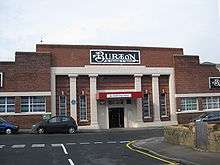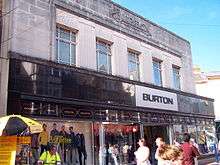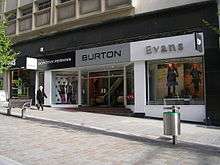Burton (retailer)
Burton is a British high street clothing retailer. The company was once a constituent of the FTSE 100 Index, but became a trading name of Arcadia Group Brands Ltd, part of the Arcadia Group. Sir Philip Green acquired the Arcadia Group in 2002, and is now the sole owner of Burton.[1]
 | |
| Burton | |
| Subsidiary | |
| Industry | retail |
| Founded | 1903 |
| Founder | Sir Montague Maurice Burton |
| Headquarters | London, W1 United Kingdom |
Number of locations | 400 stores, factories & mills |
Key people | Siobhan Forey (Chief executive officer) |
| Owner | Sir Philip Green |
| Parent | Arcadia Group |
| Website | www |
There are over 400 stores in the UK. It has also expanded to branches at out of town sites since the 1980s, such as at the Merry Hill Shopping Centre in the West Midlands, where it has had a store since November 1989.
History

The company was founded by Sir Montague Maurice Burton in Chesterfield in 1903 under the name of The Cross-Tailoring Company.[1] It was first listed on the London Stock Exchange in 1929 by which time it had 400 stores, factories and mills.[1]
After World War II, Montague Burton was one of the suppliers of demob suits to the British government for demobilising servicemen, comprising jacket, trousers, waistcoat, shirt and underwear.[1] It has been speculated that this is the origin of the phrase "the full monty". In 1946, the company acquired the Peter Robinson department store chain.[2] Montague Burton died in 1952. By this time, the company was the largest multiple tailor in the world.
The company expanded by purchasing various other brands, including competitors until was split from Debenhams in 1998. At this time Burtons became a brand name, and the Arcadia Group name took over as the group name.
The companies purchased or merged with were:
- 1954 Jackson the Tailor[3]
- 1979 Dorothy Perkins
- 1984 Harry Fenton[4]
- 1985 Debenhams
- 1986 John Collier
Burton was the official clothing supplier to the England national football team for the 1966 FIFA World Cup, UEFA Euro 1996 and the 2002 FIFA World Cup championships.[1] In 1998 the company changed its name to Arcadia Group.[5]
Philip Green purchased the company in 2002.[1]
The Burton company archives are held at the West Yorkshire Archive Service in Leeds.[6]
Architecture

Beginning in 1923, Burton began to acquire freehold sites in order to build its own custom designed stores.[7] Prominent town centre corner sites were preferred and the shops often moved a few doors along the same street in order to acquire the corner site. Leeds-based architect Harry Wilson was hired at this time and developed the Burton "house style" building design. In 1931 Burton took over Wilson's practice to make it the in-house architecture department.[8] Wilson was replaced as chief architect by Nathaniel Martin in 1937.[7]
This Burton in-house architecture was Art Deco in style. Individual stores vary from the more restrained red-brick with neoclassical scroll headed columns to fully fledged Art Deco with glazed white faience tile, geometric patterns and stylised elephant heads. However, there are also many standard elements such as a wide polished black granite band above the shop windows for signage, metal vent grates bearing the company logo, billiard halls on the upper levels, window lights showing the locations of other Burton stores, and mosaic titles – sometimes including the company logo – in the doorways.
At ground level, foundation stones were often placed by Montague Burton's four children, Barbara, Stanley, Arnold and Raymond. Each store might have one or several foundation stones, each bearing one name and the year. For example: "THIS STONE LAID BY RAYMOND MONTAGUE BURTON 1937". The children were quite young when these stones were laid. Stanley Howard was born in 1914 [9] and laid a stone for the Nottingham Beastmarket Hill store in 1924. At least six stores bear stones laid by Montague's wife "Lady Burton", and a number in the mid to late 1930s were laid by Austin Stephen Burton who may have been a grandchild.[10]
Whilst some of these Burton buildings have been destroyed over the years, many are still standing and some of them still have active snooker clubs upstairs. Some are still occupied by Burton stores (often a combined Burton and Dorothy Perkins store) but many have changed use. McDonald's first three restaurants in the UK were opened in former Burton stores in 1974 and 1975 as the company was selling property at that time.[11]
Most of the Scottish stores are listed with Historic Environment Scotland, protecting them from changes. However, only six stores in England and Wales are listed buildings, leaving over 200 with no protection from future changes or demolition. Recent years have seen stores demolished in Plymouth (2004)[12] and Neasden (2012).[13]
Stores

|
Europe:
|
Asia
|
Americas:
|
Africa:
|
Charitable activities
Burton has worked with the Bobby Moore Fund in order to publicize the issue of bowel cancer.[14] England's World-Cup-winning football team captain Bobby Moore died of bowel cancer in 1993. The Bobby Moore Fund is an arm of Cancer Research UK.
In November 2009, Burton sought to bring back "The Burton", a style of moustache worn by founder Montague Burton, through their support of the Movember campaign in order to raise money for The Prostate Cancer Charity. The "Burton" moustache was styled upon two influential moustache types; the English and the Handlebar.
References
- "About Us". Burton Menswear London. 2013. Retrieved 14 February 2018.
- "Arcadia History". Archived from the original on 9 December 2008.
- "Montague Burton: The Tailor of Taste By Eric M. Sigsworth". p. 152. Retrieved 10 November 2015.
- "Combined English looks to be out of the wood - The Glasgow Herald p.27 March 1984". Retrieved 4 December 2015.
- "Arcadia's clearance sale". BBC News. 4 April 2001. Retrieved 23 September 2013.
- West Yorkshire Archive Service, Leeds Archived 1 May 2009 at the Wayback Machine
- "Burton's Building, Aberystwyth". britishlistedbuildings.co.uk. Retrieved 27 January 2016.
- Skinner, Joan S. (1997). Form and Fancy: Factories and Factory Buildings by Wallis, Gilbert & Partners, 1916-1939 (1st ed.). Liverpool: Liverpool University Press. p. 215. ISBN 0853236127.
- "Moving Here Migration Histories: Sir Montague Burton and his Business Expansion". webarchive.nationalarchives.gov.uk. Archived from the original on 5 November 2013. Retrieved 16 November 2016.
- "Austin Stephen Burton". londonremembers.com. Retrieved 28 January 2016.
- "McDonald's amazing growth in UK". telegraph.co.uk. Retrieved 28 January 2016.
- "City centre revamp is under way". bbc.co.uk. Retrieved 28 January 2016.
- "Galway Hooker". whatpub.com. Retrieved 28 January 2016.
- Hardie, Charlotte (11 September 2008). "Charity begins on the high street". Retail Week.